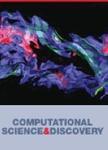版权所有:内蒙古大学图书馆 技术提供:维普资讯• 智图
内蒙古自治区呼和浩特市赛罕区大学西街235号 邮编: 010021

作者机构:Knowledge Discovery and Informatics Pacific Northwest National Laboratory RichlandWA99352 United States Applied Statistics and Computational Modeling Group Pacific Northwest National Laboratory RichlandWA99352 United States Department of Computer Science and Engineering Washington University in St. Louis St. LouisMO63130 United States Division of Rheumatology Department of Medicine Washington University School of Medicine St. LouisMO63110 United States Division of Cardiology Department of Medicine Washington University School of Medicine St. LouisMO63110 United States
出 版 物:《Computational Science and Discovery》 (Comput. Sci. Discov.)
年 卷 期:2014年第7卷第1期
页 面:015003-15002页
核心收录:
学科分类:0711[理学-系统科学] 0817[工学-化学工程与技术] 08[工学] 0703[理学-化学] 0701[理学-数学] 0702[理学-物理学] 0812[工学-计算机科学与技术(可授工学、理学学位)]
基 金:National Institutes of Health U.S. Food and Drug Administration, (U01NS073457)
主 题:Nanoparticles
摘 要:Nanoparticles are potentially powerful therapeutic tools that have the capacity to target drug payloads and imaging agents. However, some nanoparticles can activate complement, a branch of the innate immune system, and cause adverse side-effects. Recently, we employed an in vitro hemolysis assay to measure the serum complement activity of perfluorocarbon nanoparticles that differed by size, surface charge, and surface chemistry, quantifying the nanoparticle-dependent complement activity using a metric called Residual Hemolytic Activity (RHA). In the present work, we have used a decision tree learning algorithm to derive the rules for estimating nanoparticle-dependent complement response based on the data generated from the hemolytic assay studies. Our results indicate that physicochemical properties of nanoparticles, namely, size, polydispersity index, zeta potential, and mole percentage of the active surface ligand of a nanoparticle, can serve as good descriptors for prediction of nanoparticle-dependent complement activation in the decision tree modeling framework. © 2014 IOP Publishing Ltd.